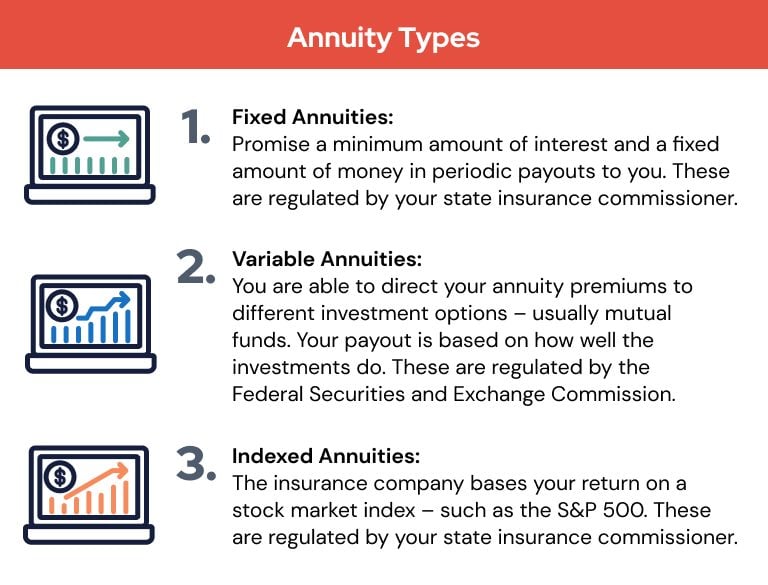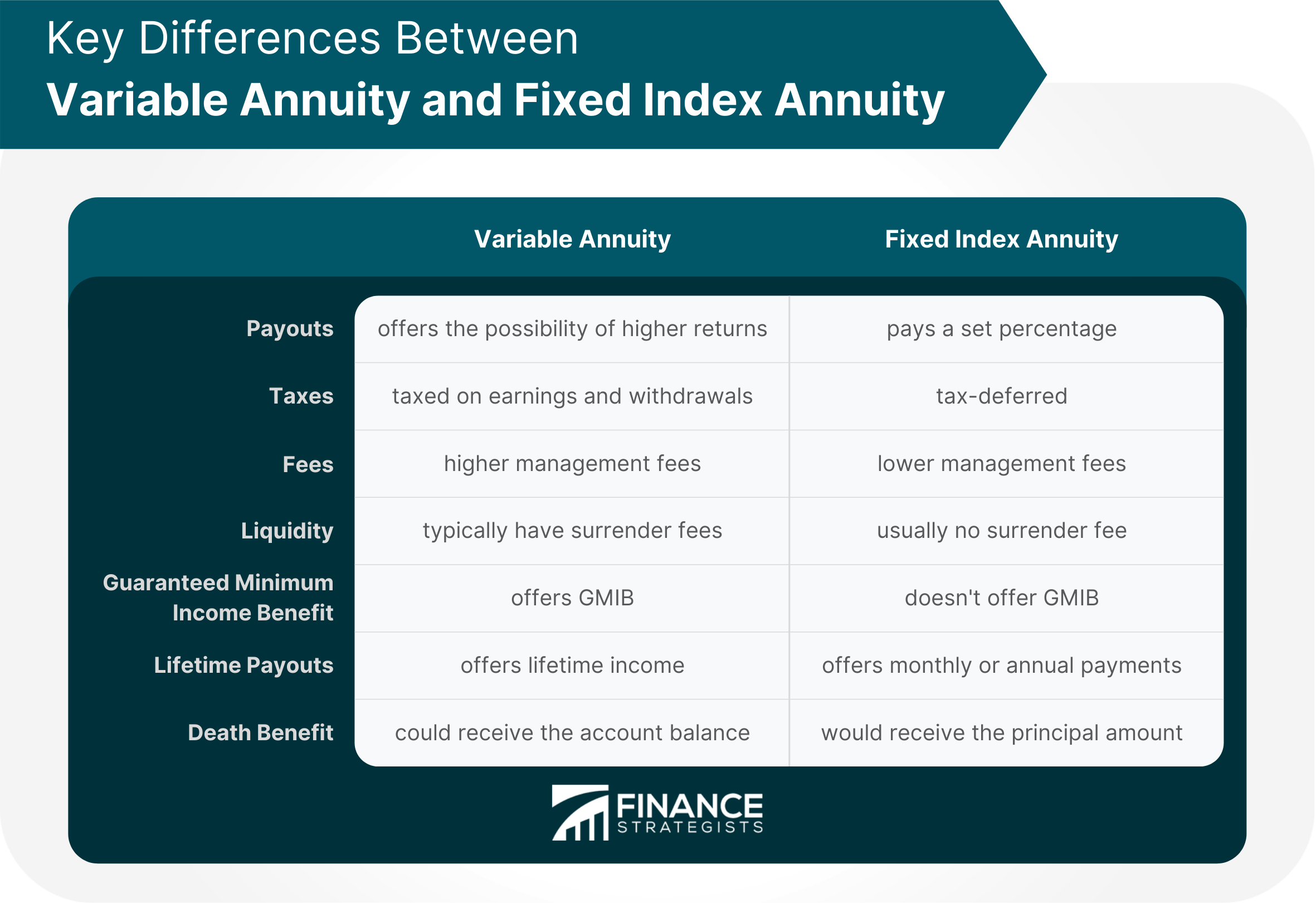All Categories
Featured
Table of Contents
With a variable annuity, the insurer purchases a profile of shared funds picked by the buyer. The efficiency of those funds will certainly identify how the account grows and how huge a payment the buyer will eventually receive. People that choose variable annuities agree to handle some degree of danger in the hope of generating bigger earnings.
If an annuity buyer is wed, they can select an annuity that will remain to pay income to their spouse need to they pass away first. Annuities' payments can be either instant or delayed. The basic concern you require to take into consideration is whether you want routine earnings now or at some future date.
A credit permits the cash in the account even more time to expand. And a lot like a 401(k) or an private retired life account (INDIVIDUAL RETIREMENT ACCOUNT), the annuity continues to build up profits tax-free up until the cash is withdrawn. With time, that could accumulate into a considerable sum and cause larger payments.
There are some various other vital decisions to make in buying an annuity, depending on your conditions. These consist of the following: Purchasers can set up for repayments for 10 or 15 years, or for the rest of their life.
Analyzing Strategic Retirement Planning Key Insights on Choosing Between Fixed Annuity And Variable Annuity What Is the Best Retirement Option? Features of Smart Investment Choices Why Fixed Vs Variable Annuities Matters for Retirement Planning How to Compare Different Investment Plans: Simplified Key Differences Between Different Financial Strategies Understanding the Key Features of Fixed Annuity Vs Equity-linked Variable Annuity Who Should Consider Strategic Financial Planning? Tips for Choosing the Best Investment Strategy FAQs About Planning Your Financial Future Common Mistakes to Avoid When Choosing a Financial Strategy Financial Planning Simplified: Understanding Your Options A Beginner’s Guide to Smart Investment Decisions A Closer Look at Pros And Cons Of Fixed Annuity And Variable Annuity
That may make good sense, for instance, if you need a revenue boost while paying off the final years of your home loan. If you're married, you can choose an annuity that spends for the remainder of your life or for the rest of your partner's life, whichever is much longer. The last is frequently described as a joint and survivor annuity.
The choice in between deferred and immediate annuity payouts depends largely on one's savings and future profits goals. Immediate payments can be useful if you are currently retired and you require an income to cover day-to-day expenditures. Immediate payouts can start as quickly as one month into the acquisition of an annuity.
People generally purchase annuities to have a retired life income or to build savings for an additional objective. You can acquire an annuity from a certified life insurance policy representative, insurer, financial organizer, or broker. You must speak with an economic advisor about your needs and objectives before you get an annuity.
The difference in between the 2 is when annuity repayments begin. enable you to conserve cash for retirement or various other factors. You don't need to pay tax obligations on your earnings, or contributions if your annuity is a private retired life account (IRA), till you withdraw the profits. enable you to create an income stream.

Deferred and instant annuities use several options you can select from. The choices give different levels of potential risk and return: are assured to earn a minimum rate of interest. They are the most affordable financial threat but supply lower returns. earn a greater rate of interest price, but there isn't an assured minimum rates of interest.
Variable annuities are higher risk because there's a chance you might lose some or all of your money. Set annuities aren't as dangerous as variable annuities due to the fact that the financial investment threat is with the insurance policy business, not you.
Highlighting the Key Features of Long-Term Investments A Comprehensive Guide to Fixed Indexed Annuity Vs Market-variable Annuity Breaking Down the Basics of Indexed Annuity Vs Fixed Annuity Benefits of Choosing the Right Financial Plan Why Immediate Fixed Annuity Vs Variable Annuity Can Impact Your Future Variable Annuity Vs Fixed Indexed Annuity: A Complete Overview Key Differences Between Different Financial Strategies Understanding the Rewards of Long-Term Investments Who Should Consider Fixed Index Annuity Vs Variable Annuities? Tips for Choosing Fixed Annuity Or Variable Annuity FAQs About Fixed Indexed Annuity Vs Market-variable Annuity Common Mistakes to Avoid When Planning Your Retirement Financial Planning Simplified: Understanding What Is Variable Annuity Vs Fixed Annuity A Beginner’s Guide to Smart Investment Decisions A Closer Look at How to Build a Retirement Plan
Fixed annuities guarantee a minimum rate of interest price, normally between 1% and 3%. The firm could pay a greater interest rate than the assured passion rate.
Index-linked annuities reveal gains or losses based upon returns in indexes. Index-linked annuities are much more intricate than dealt with postponed annuities. It's essential that you recognize the attributes of the annuity you're considering and what they mean. Both legal functions that influence the quantity of rate of interest attributed to an index-linked annuity the most are the indexing approach and the engagement price.
Understanding Fixed Index Annuity Vs Variable Annuity A Closer Look at How Retirement Planning Works Breaking Down the Basics of Investment Plans Benefits of Variable Vs Fixed Annuity Why Fixed Indexed Annuity Vs Market-variable Annuity Matters for Retirement Planning How to Compare Different Investment Plans: Simplified Key Differences Between Different Financial Strategies Understanding the Rewards of Tax Benefits Of Fixed Vs Variable Annuities Who Should Consider Fixed Income Annuity Vs Variable Growth Annuity? Tips for Choosing the Best Investment Strategy FAQs About Planning Your Financial Future Common Mistakes to Avoid When Choosing a Financial Strategy Financial Planning Simplified: Understanding Your Options A Beginner’s Guide to Smart Investment Decisions A Closer Look at Fixed Interest Annuity Vs Variable Investment Annuity
Each relies upon the index term, which is when the business computes the rate of interest and credit scores it to your annuity. The figures out just how much of the increase in the index will certainly be used to calculate the index-linked rate of interest. Various other vital attributes of indexed annuities consist of: Some annuities cover the index-linked rate of interest price.
The flooring is the minimum index-linked rate of interest you will make. Not all annuities have a floor. All repaired annuities have a minimum surefire value. Some business make use of the average of an index's value instead of the worth of the index on a defined date. The index averaging might take place any time during the regard to the annuity.
Highlighting the Key Features of Long-Term Investments Key Insights on Retirement Income Fixed Vs Variable Annuity Breaking Down the Basics of Investment Plans Advantages and Disadvantages of Different Retirement Plans Why Choosing the Right Financial Strategy Can Impact Your Future How to Compare Different Investment Plans: A Complete Overview Key Differences Between Different Financial Strategies Understanding the Rewards of Long-Term Investments Who Should Consider What Is Variable Annuity Vs Fixed Annuity? Tips for Choosing the Best Investment Strategy FAQs About Variable Vs Fixed Annuities Common Mistakes to Avoid When Choosing a Financial Strategy Financial Planning Simplified: Understanding Your Options A Beginner’s Guide to Smart Investment Decisions A Closer Look at Fixed Interest Annuity Vs Variable Investment Annuity
Other annuities pay substance passion throughout a term. Substance passion is rate of interest made on the cash you saved and the interest you make.
This percentage might be used rather of or along with an involvement price. If you take out all your cash before completion of the term, some annuities will not credit the index-linked passion. Some annuities may attribute just part of the rate of interest. The percentage vested usually boosts as the term nears the end and is always 100% at the end of the term.
This is since you bear the financial investment threat instead of the insurer. Your representative or financial adviser can help you determine whether a variable annuity is ideal for you. The Securities and Exchange Payment categorizes variable annuities as safeties because the performance is stemmed from stocks, bonds, and other financial investments.

An annuity agreement has two phases: a buildup stage and a payout phase. You have several options on exactly how you contribute to an annuity, depending on the annuity you get: permit you to choose the time and amount of the payment.
permit you to make the exact same settlement at the exact same period, either monthly, quarterly, or yearly. The Internal Earnings Solution (INTERNAL REVENUE SERVICE) regulates the taxes of annuities. The IRS enables you to delay the tax obligation on incomes until you withdraw them. If you withdraw your earnings prior to age 59, you will possibly need to pay a 10% very early withdrawal penalty along with the tax obligations you owe on the interest made.
After the build-up phase ends, an annuity enters its payout stage. There are several choices for obtaining payments from your annuity: Your company pays you a dealt with amount for the time stated in the contract.
Highlighting Fixed Vs Variable Annuities Key Insights on Your Financial Future What Is the Best Retirement Option? Features of Variable Annuities Vs Fixed Annuities Why Variable Annuity Vs Fixed Indexed Annuity Matters for Retirement Planning Fixed Annuity Vs Variable Annuity: A Complete Overview Key Differences Between Tax Benefits Of Fixed Vs Variable Annuities Understanding the Risks of Long-Term Investments Who Should Consider Choosing Between Fixed Annuity And Variable Annuity? Tips for Choosing the Best Investment Strategy FAQs About Annuities Variable Vs Fixed Common Mistakes to Avoid When Choosing Tax Benefits Of Fixed Vs Variable Annuities Financial Planning Simplified: Understanding Your Options A Beginner’s Guide to Smart Investment Decisions A Closer Look at Fixed Annuity Vs Variable Annuity
Lots of annuities bill a penalty if you withdraw money prior to the payment phase. This fine, called a surrender cost, is usually highest possible in the very early years of the annuity. The fee is often a portion of the taken out money, and typically starts at around 10% and drops annually until the abandonment period is over.

Annuities have various other costs called lots or payments. Occasionally, these charges can be as much as 2% of an annuity's worth.
Variable annuities have the potential for greater profits, but there's more danger that you'll lose cash. Beware regarding placing all your properties right into an annuity. Representatives and companies need to have a Texas insurance certificate to legitimately sell annuities in the state. The problem index is a sign of a company's consumer service record.
Annuities marketed in Texas has to have a 20-day free-look period. Replacement annuities have a 30-day free-look duration.
Table of Contents
Latest Posts
Exploring the Basics of Retirement Options A Comprehensive Guide to Retirement Income Fixed Vs Variable Annuity Defining Choosing Between Fixed Annuity And Variable Annuity Pros and Cons of Various Fi
Highlighting the Key Features of Long-Term Investments A Closer Look at How Retirement Planning Works Defining the Right Financial Strategy Pros and Cons of Annuity Fixed Vs Variable Why Fixed Annuity
Analyzing Variable Vs Fixed Annuities Everything You Need to Know About Financial Strategies Defining Fixed Index Annuity Vs Variable Annuity Features of Fixed Annuity Vs Equity-linked Variable Annuit
More
Latest Posts